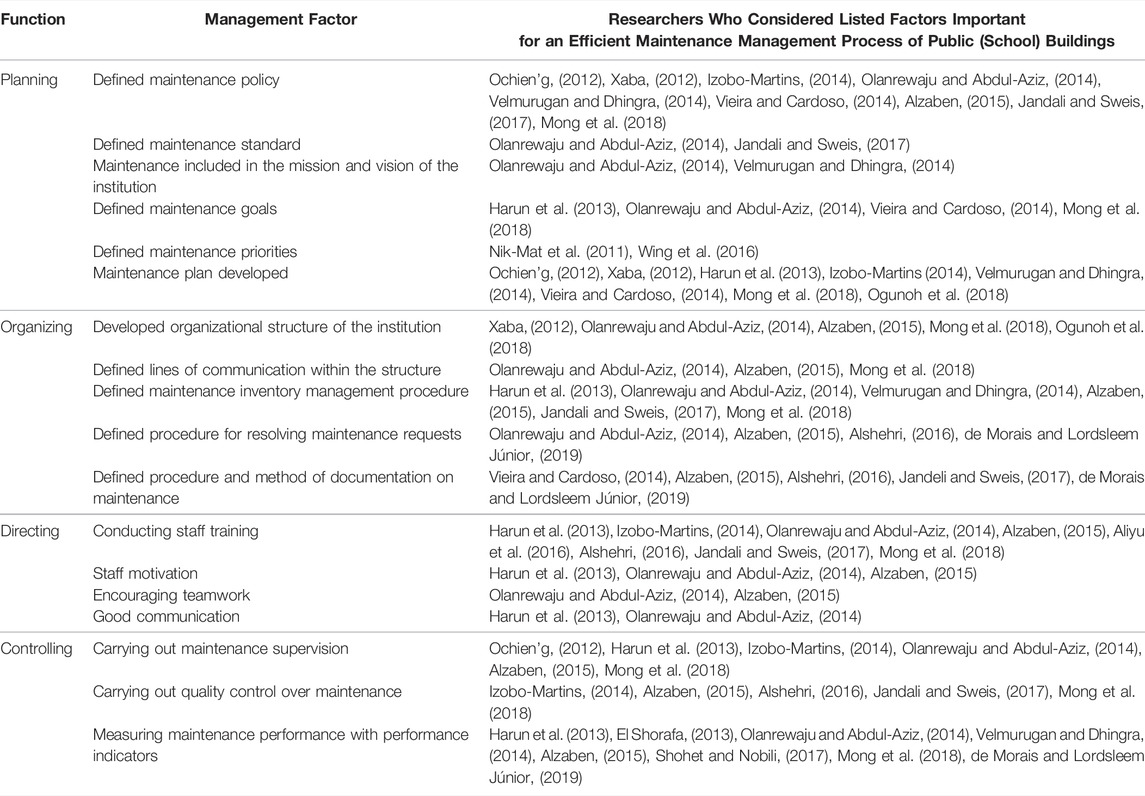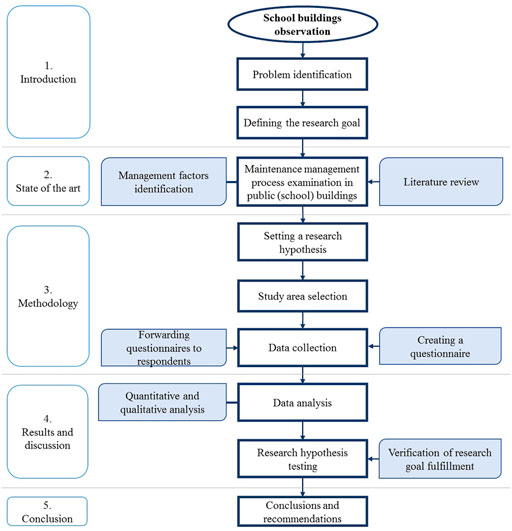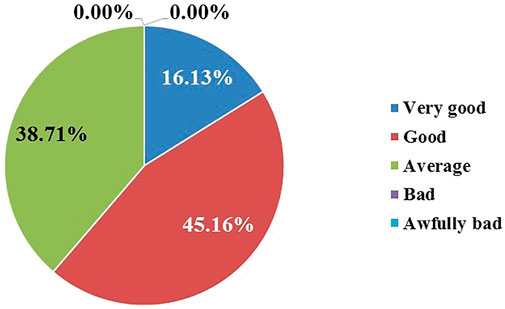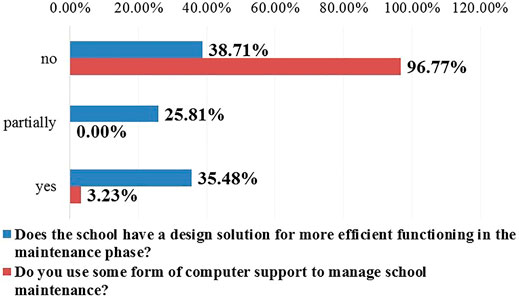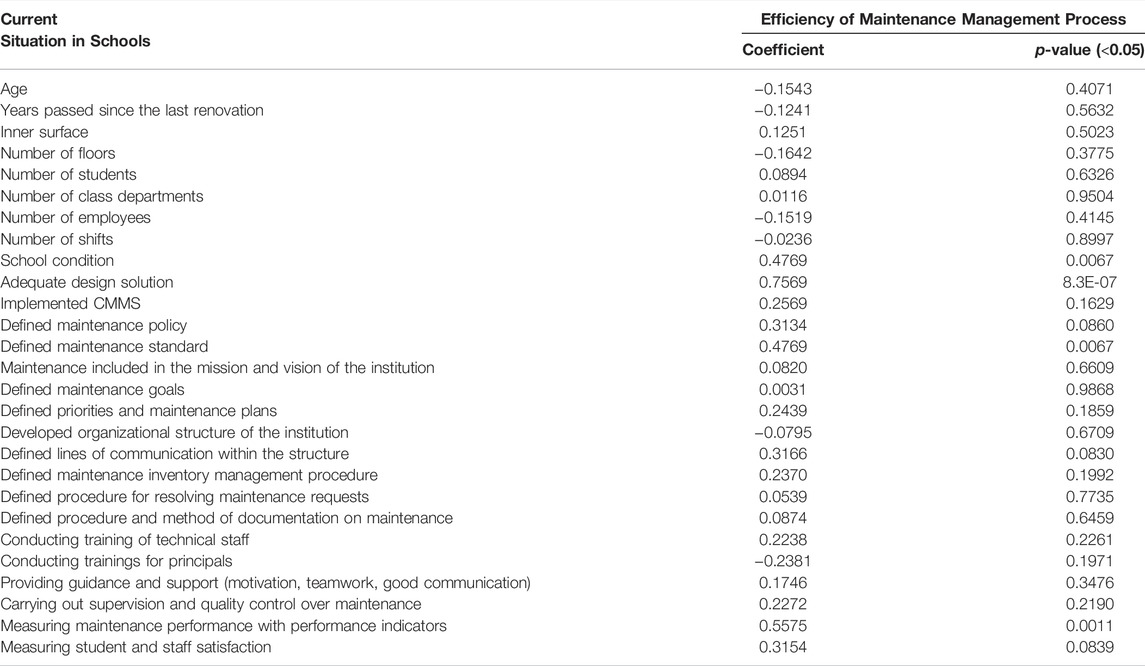- 1Faculty of Civil Engineering, University of Rijeka, Rijeka, Croatia
- 2Faculty of Civil Engineering and Architecture Osijek, Josip Juraj Strossmayer University of Osijek, Osijek, Croatia
Due to their educational purpose, impact on users and quality of education, school buildings are vital institutions in the community, and their adequate maintenance should be mandatory. Studies conducted around the world point to specific inadequacies that occur in the school maintenance segment, however studies that examine the entire maintenance management process in detail are rare. With such studies, it is possible to observe all components of maintenance and its management in the observed buildings, it is possible to get a detailed insight into the present inadequacies and problems, and give the best possible answer to them. Observing the territory of the Republic of Croatia, it was noticed that there are no adequate databases on school building maintenance. Given all the above, this paper aims to establish a methodological framework and analyze the entire maintenance management process in Croatian schools to detect potential inadequacies, reveal problems, and identify areas for action to improve maintenance performance and carry out maintenance more efficiently. The current maintenance management process of elementary school buildings in the Primorje-Gorski Kotar County, Republic of Croatia, was examined based on the developed methodological framework. Data on the management process were collected through a questionnaire survey among school principals. The questionnaire was compiled based on an extensive literature review. Maintenance performance through management functions was investigated, namely: maintenance planning, maintenance organization, maintenance directing, and maintenance controlling. Important management factors within each of the mentioned functions were observed. The data analysis revealed specific inadequacies and problems in the maintenance process, and it was shown that maintenance management is not entirely effective. Recommendations were given to improve the current situation. In this way, it is possible to quickly and easily examine the entire management process and identify measures that need to be introduced in schools to improve their business in the maintenance segment. The developed methodological framework can be applied to schools from other areas as well as to other types of buildings.
1 Introduction
Concerning their educational purpose, school buildings are essential facilities in the community (Katić et al., 2021). Their function is to protect users and equipment from natural influences and provide internal space for learning and teaching (Palis and Misnan, 2018).
Education is crucial for human development, facilitates a healthy mindset and develops cognitive abilities (Sharma, 2020). Education through the development of individuals also affects society as a whole and is a direct driver of its economic, social, political (and all other) growth and development (Tijanić Štrok, 2021). Quality of education depends significantly on the state of built assets in which it is provided (Xaba, 2012; Yong and Silieman, 2015; Teixeira et al., 2017). For school buildings to be of high quality and to perform their required function, it is necessary to implement their maintenance continuously.
Building maintenance can be defined as a set of all activities undertaken to preserve, protect and improve buildings (following the standards in force) to serve the intended functions during the building exploitation phase. Maintenance management is a practice of Facility Management (FM) that establishes strategies, goals, maintenance responsibilities, ways of performing maintenance, with their implementation through functions of planning, organizing, directing and controlling (Tijanić Štrok, 2021).
No comprehensive research on school buildings maintenance has been conducted so far in the Republic of Croatia. There are no adequate maintenance databases, no records of the state of the maintenance management process, and there is no effective framework within which maintenance work would be performed, so maintenance is often neglected, disorganized, expensive, and does not provide value for money (Tijanić Štrok, 2021).
According to the conducted studies, inadequate state of schools is a pattern that appears everywhere in the world (Xaba, 2012; Albader and Kandil, 2013; ElSamadony et al., 2013; Izobo-Martins, 2014; Ropi and Tabasi, 2014; Vieira and Cardoso, 2014; Dickerson and Ackerman, 2016; Wuni et al., 2018). Studies that approach maintenance by observing the overall school maintenance management process are rare.
Considering the stated, this paper aims to establish a methodological framework for the analysis of the overall school maintenance management process. The framework will quickly and easily detect potential inadequacies and problems and identify the areas to be affected to improve the maintenance performance, i.e., to make the school maintenance more efficient.
Along with the Introduction, the paper is organized as follows: Chapter 2 provides a detailed literature review within which adequate maintenance management factors for public (educational) buildings have been identified; Chapter 3 presents the developed research methodological framework and describes the study area as well as the data collection method and the characteristics of the collected data; in Chapter 4, an analysis of the data collected and a discussion of the results was conducted; Chapter 5 provides concluding remarks and recommendations.
2 State of the Art
2.1 Previous Research on the School Buildings Maintenance
The school maintenance program is an organizational activity carried out by the school community to extend the lifespan of the school building with all its parts. School maintenance refers to the repair, replacement, and general maintenance of physical characteristics found in school buildings, terrain and safety systems (Izobo-Martins, 2014).
School buildings are specific and fail rapidly due to their age, overcapacity, extensive use (ElSamadony et al., 2013; Saraiva et al., 2018). A great challenge is the various building components with different repair requirements (ElSamadony et al., 2013). Schools are often located in buildings whose original purpose was not educational, and a number of them have been declared a cultural asset which makes maintenance even more difficult due to the special requirements to be met (Tijanić Štrok, 2021).
Different research on school buildings maintenance was conducted in Asia, primarily Malaysia. It was found that there is no adequate maintenance knowledge base; the attitude toward maintenance is mostly negative; the maintenance workforce is unqualified (Nah et al., 2012); the maintenance is neglected in the design phase (Ali et al., 2013); the planned maintenance is not applied; the funding is not sufficient to meet all the maintenance needs (Ropi and Tabasi, 2014); the users are dissatisfied with the buildings in which they are educated or work (Yong and Sulieman, 2015). In other countries, research outcomes show similar results.
Liu et al. (2021) point out that proper maintenance was neglected in schools in Indonesia. Izobo-Martins, (2014) showed in Nigeria that in secondary schools, users are not satisfied with the building’s maintenance and that there is no maintenance policy that would define the procedure and method of maintenance implementation of the aforementioned institutions. Albader and Kandil, (2013) (USA) develop a framework for improving the overall school buildings state that will improve the inefficient use of maintenance funds and improve students’ performance. Dickerson and Ackerman (2016) point out that a quarter of schools in the United States are in a weaker operational state and that they require major repairs. The inadequate condition also have school buildings in Egypt where Marzouk and Award (2016) developed a model for assessing the state of schools based on the Analytic Hierarchy Process (AHP). A survey conducted by Xaba (2012) in South Africa showed that school maintenance mostly comes down to emergency and corrective interventions. Wuni et al. (2018) research the school maintenance in the Ghana area and establish that the causes of inadequate management are the lack of professional maintenance managers, postponement of maintenance, budgetary constraints, deviations in planning, non-connection of the design phase with later project phases.
The public school building’s funding is usually from the state budget, so it is limited. Insufficient financial resources and their inefficient spending are facts that flow through numerous research therefore certain researchers have developed cost estimation models based on methods such as regression analysis, neural networks, etc., to contribute to solving this problem (ElSamadony et al., 2013; Lee and Jeon, 2017; Kim et al., 2018).
Systematic research on school buildings maintenance in the Republic of Croatia has not been conducted so far. There are sporadic studies and literature reports that point to certain inadequacies in the current management process. According to the State Audit Office, (2018), Croatian schools operate in outdated facilities, as much as 25% of all schools were built more than 80 years ago, resulting in neglect and damage due to wear-out and inadequate maintenance. The lack of regular maintenance is mainly attributed to insufficient budget allocations from the public administration (Tijanić Štrok, 2021).
In some schools, health and ecologically unacceptable materials such as asbestos are still installed. School founders do not keep records of the condition and equipment of the schools they manage (State Audit Office, 2018; Tijanić Štrok, 2021). The Government of the Republic of Croatia (2012) points out that there is a great need at the level of the Republic of Croatia to invest in public infrastructure, including schools.
The research on health and environmental conditions in schools was also carried out by Capak et al. (2015) and found that there are problems with the moisture and mold in schools, as well as the state of sanitary nodes. According to this research, weaker construction and technical condition of the observed school buildings need to be solved by rehabilitation and reconstruction based on sustainable architectural solutions.
2.1.1 School Buildings Maintenance Management Factors
Building maintenance management implies integrating four primary management functions: maintenance planning, maintenance organization, maintenance directing, and maintenance controlling. Functions are consecutive but interconnect and sometimes overlap (Olanrewaju and Abdul-Aziz, 2014). The building maintenance management process model is shown in Figure 1.
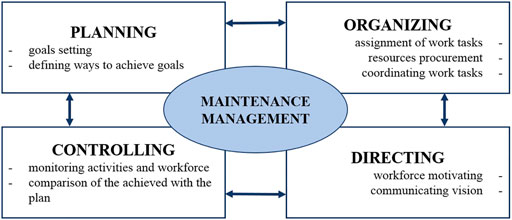
FIGURE 1. Maintenance management model (adapted from Ogunoh et al., 2018).
Management activities (factors) within prominent functions are the main part of this model since their implementation fulfills the conditions for creating an adequate management process. It is important to identify all those factors that are appropriate for individual types of buildings to develop an adjusted, robust and comprehensive framework for their effective management.
Effective school maintenance management, according to Tijanić Štrok (2021), means proactive and high-quality implementation of maintenance activities while minimizing resource consumption, primarily maintenance costs, avoiding work interruptions, and increasing staff and student satisfaction by creating conditions that ensure their health and safety, facilitating teaching, learning and improving academic results. The school maintenance management factors should support the fulfillment of precisely these criteria.
To recognize the aforementioned factors, a detailed literature analysis was conducted and Table 1 was created, summarizing the attitudes of the relevant newer researchers on the factors necessary for implementation into the maintenance management process. In order to obtain a more extensive overview of factors, research dealing with various types of public buildings has been elaborated, while Table 1 includes those which, according to the authors of this paper, have a direct impact on school buildings. The implementation of these factors contributes to more efficient maintenance management. Factors are divided within the previously mentioned management functions.
According to Olanrewaju and Abdul-Aziz, (2014), recognizing and fulfilling users’ expectations is an important part of effective maintenance management of educational institutions, especially since users’ needs are becoming increasingly demanding. Efficient learning and teaching can only take place in a favorable environment for users therefore within the system of performance indicators, it is necessary to examine how satisfied the users are with this environment (Tijanić Štrok, 2021).
During the maintenance process, considering a large number of management factors, there is a huge amount of different information. For this reason, light is thrown on the characteristics of computer information systems and the way they handle information. Computer support has recently been recognized as an irreplaceable and indispensable factor for more efficient maintenance of buildings (Alzaben, 2015; Shohet and Nobili, 2017; Wong et al., 2018). The software can include management functions in one place as well as all stakeholders participating in the process and serves as maintenance data storage. The Computerized Maintenance Management System (CMMS) creates a decision-making platform and is a kind of maintenance management guide. CMMS application in schools is beneficial primarily because of the highlighted maintenance problems and the complexity of school buildings, the amount of data generated in them, limited resources, the number of users and their specific needs (Tijanić Štrok, 2021).
In order to create the basis for effective school maintenance management, some authors point out that it is important to consider decisions made before the phase of facility use, primarily the design phase is considered (Ali et al., 2013; Jandali and Sweis, 2017; Ogunoh et al., 2018). It can often be established that buildings are expensive for maintenance due to inappropriate priorities during project preparation. At this stage, the right decisions and a proper plan can save a lot, so maintenance experts should be consulted from the earliest project stages (Aliya et al., 2016). At the design stage, maintenance costs should already be planned in the form of a life costs analysis when different project variants can be developed and the most cost-effective ones can be selected (Tijanić Štrok, 2021). Buildings should be designed/built so that their maintenance requires minimum costs and time (Olanrewaju and Abdul-Aziz, 2014).
For all recognized management factors, their functioning in school buildings’ current maintenance management process will be examined.
3 Methodology
After systematic consideration of the authors on the research problem, a methodological framework was developed based on which this research is conducted.
The research was conducted through several segments, which are in a meaningful way divided within the chapters of this paper. The methodological framework shows how the current maintenance management process in school buildings will be analyzed, as shown in Figure 2.
The research consists of two distinctive fields, theoretical examination and analysis of literature, and data collection and processing for the selected study area.
Within theoretical consideration, it was observed that problems in their maintenance are repeatedly present in school buildings. No efforts were made to create broader databases on maintenance inadequacies, which would provide valuable data to help identify the necessary measures to improve the current situation.
After the research aim (stated in the Introduction) has been defined, a detailed literature analysis has been conducted, identifying all important segments and functions within the school maintenance management process and identifying factors that can help create a more efficient management process.
The following hypotheses of research have been created:
• with the help of a defined methodological framework, it is possible to analyze the current maintenance management process in school buildings;
• current school maintenance management is not fully effective, i.e., there are inadequacies in maintenance management that can be affected through the introduction of adequate improvement measures.
Hypotheses will be examined in the case study area covering the territory of Primorje-Gorski Kotar County in the Republic of Croatia. The study is limited to public elementary schools in the mentioned area.
The case study area will provide a comprehensive analysis of the school maintenance management process in the selected area. The aim is to develop a methodological framework and theories on a smaller data sample that will be applicable for the entire school population as well as with certain modifications for other types of facilities. The sample size in the research is not all that determines the scientific strength, but a consistent and systematic approach and suitability for purpose are also important.
Databases will be collected within the observed area using the questionnaire survey. The questionnaire was recognized as an adequate method of data collection due to the size of the study area and the number of schools in it, the amount of data needed and the duration of the study.
Once the data have been collected, they will be processed mainly by quantitative methods (statistical analysis), after which we will get an insight into the results, which will enable verification of the authenticity of the hypotheses set.
The last step in the research is to draw conclusions with certain recommendations.
3.1 Case Study Area
The area covered by the study is located in the western part of the Republic of Croatia and covers the area of Primorje-Gorski Kotar County. Primorje-Gorski Kotar County covers 3,587 km2 of populated area, where about 6.9% of the population of Croatia resides with an average population density of 83 inhabitants/km2. Its seat is Rijeka, Croatia’s third-largest city. The County comprises 14 towns and 22 municipalities and 510 settlements in towns and municipalities (Primorje- Gorski Kotar County, 2020).
Out of 21 areas in the Republic of Croatia, the Primorje-Gorski Kotar County is the fourth in the number of elementary schools.
Fifty-seven public elementary schools are operating by County area. The largest number of schools, thirty-one of them, is managed by Primorje-Gorski Kotar County, the City of Rijeka runs twenty-three schools, two schools are run by the town of Crikvenica, while the town of Opatija is the founder of one school.
Primorje-Gorski Kotar County was selected as an area of research due to the availability of data, development, size and sufficient number of elementary schools to create a representative data sample.
3.2 Survey Questionnaire
A survey was conducted among elementary school principals. The questionnaire consisted of three parts in which three data groups were requested.
The first group of data consists of general data on school buildings collected in order to obtain knowledge on the basic sample characteristics. Data on construction year, last renovation year, the total building inner surface, floors, number of students, departments, employees, shifts, the operational state of the school building; are requested.
The second part of the questionnaire examines the state of the current maintenance management process in school buildings. Questions were raised about the establishment of recognized management factors (Table 1) in the current school maintenance management process. The factors in this paper imply activities (criteria or subfunctions) within maintenance management functions that must be implemented for the whole maintenance process to function effectively. The questionnaire in this part of the survey is in the form of a 3-degree Likert scale, where the questions asked have answers in forms: no (1)—partially (2)—yes (3).
The third questionnaire part consists of the principal’s views. In this part, the principals could leave their comments or point out, according to them, the biggest problems in the current maintenance management process.
The questionnaire is anonymous. To improve the questionnaire design and response rate, questions are as simple and shorter as possible. Where possible within the questionnaire, Cronbach’s alpha test was used to measure reliability. The usual rule for surveys conducted in questionnaires form is that the results with Cronbach’s alpha coefficient above 0.700 are considered acceptable (Kušljić, 2012). The questionnaire was changed several times, while in cooperation with two construction experts it was not estimated that a sufficiently valid and reliable version was obtained.
Questionnaires were sent to the examinees via e-mail. They were forwarded to a total of 57 addresses and 31 respondents replied to the questionnaire, representing a return rate of 54.38%. Taking into account that certain surveys on similar issues were carried out on samples of a smaller number and lower rates of return (Oyenuga et al., 2012; Xaba, 2012; ElSamadony et al., 2013; El Shorafa, 2013; Olanrewaju and Abdul-Aziz, 2014), the questionnaire return rate is considered acceptable for the continuation of this study.
4 Results and Discussion
Since data were collected for 31 schools (>30), a normal distribution is presumed for the data sample (Kušljić, 2012).
The collected data are statistically processed in the Microsoft Excel software and the results are presented below.
Descriptive data statistics on the general school characteristics are presented in Table 2.
The observed elementary schools are 69 years old on average. The oldest school was built in 1876 and the youngest in 2005. Most of the observed schools had a certain type of reconstruction or upgrade during their existence, and on average 18 years have elapsed since such greater intervention, compared to 2022. The school inner surface is around 2,600.00 m2 with an average of 2.3 floors. The smallest facility in the sample has a surface area of 554.00 m2, while the largest surface area is almost 6,000.00 m2. On average, looking at the sample of schools, the number of students in them is 245.55. They are deployed in 14.48 departments. There are 44 employees in schools, taking into account non-teaching personnel. Schools mostly work in one shift. These data refer to the school year 2020/2021.
Within the first part of the questionnaire, principals assessed the operational (physical) state of schools considering the issue of damage to the building. Within the literature review, it has been established that there is no record of damage and condition of school buildings (Tijanić Štrok, 2021), therefore this situation has yet to be established. Knowledge about the condition and damages of school buildings is valuable data for creating a priorities system for the school buildings maintenance. The principals evaluated the status of their school with scores from 1 to 5, where grade 1 signifies awfully bad condition and 5 marks a very good condition. The results are shown in Figure 3.
According to principals, the largest number of schools, 14 of them, have a good (4) operational condition. There are 12 schools with average (3) condition (neither good nor bad). No principal rated the state of his school as bad (2) or awfully bad (1). In future research, it is recommended to examine the state of schools of all important elements of the structure to obtain a more detailed perception of the problem of damage on buildings. It is important to ensure that all students have equal conditions for work and study.
In the second part of the questionnaire, principals were directly asked whether, in their opinion, the current overall maintenance management process is efficient, positive response ''yes'' was given by 8, i.e., 25.81% respectively, while all others consider that it is not (22.58%) or that it is only partially effective (51.61%).
In order to determine efficiency within management functions, the principal’s cognition of the functioning of certain management factors within the functions of planning, organizing, directing, and controlling maintenance, was examined. Responses within the questionnaire refer to whether these factors are implemented within the current school maintenance management process. The reliability control of this part of the questionnaire was performed, and Cronbach’s alpha coefficient of 0.8654 was obtained, which is a satisfactory result. The questionnaire survey results are given in Table 3.
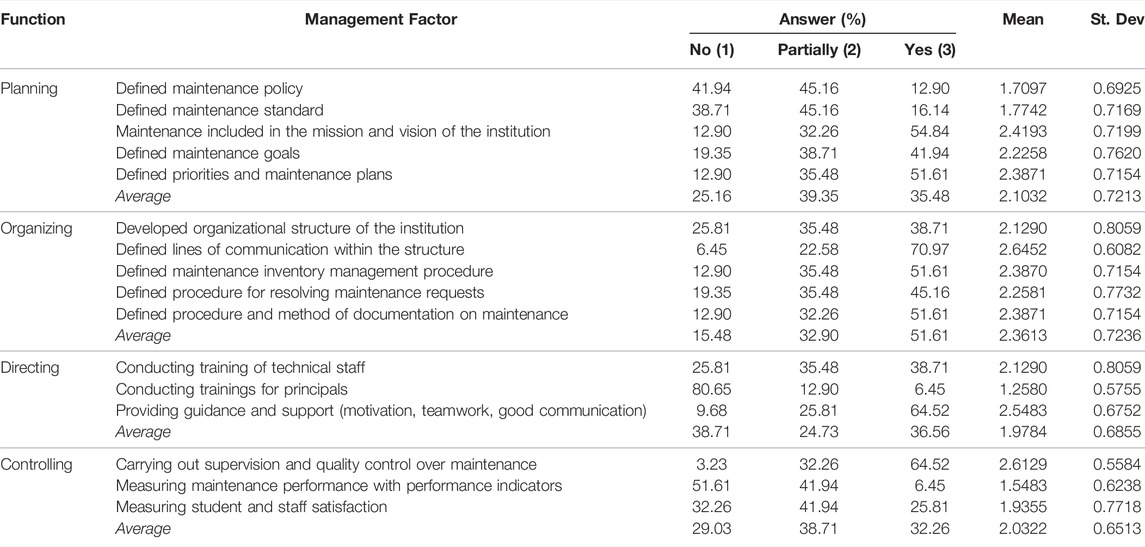
TABLE 3. Are individual maintenance management factors implemented in the current school maintenance management process?
Given the scale used, it was determined that in order for the implementation of a certain function or factor in the school sample to be considered sufficiently satisfactory, the mean value of the data should be at least 2.50.
From Table 3, it can be seen that only a few factors have been implemented at a satisfactory level. The most positive responses were given to the factor concerning defined communication lines between maintenance personnel, 70.97%. A high proportion of the answers in part and extremely negative answers are concerns. A very high percentage of the answer ''no'' has a factor that concerns the education of the principal, as much as 80.65%. This trend is risky because all maintenance requests should have a starting point in the school principal. The principal is involved in building management and administrative issues. The principal’s responsibility as head of the school is to initiate the procedure for the maintenance of the school building and to inform the founder of all problems (Tijanić Štrok, 2021). The principals often do not have any technical knowledge, they come from among the teachers, and therefore certain education would undoubtedly be helpful and compulsory.
The factor that also has a high share of negative responses concerns the measurement of maintenance performance by performance indicators. Performance indicators are used to monitor the performance of business processes and planned objectives, in this case, the maintenance management process, which is one of the fundamental activities of operations within public institutions. Implementation of performance indicators is very important because, in this way, an analysis of achievements in the field of maintenance can be performed. By reviewing achievements, adequate changes and improvements can be made in future planning, decision making, organization of works, etc. This process is the basis for systematic and continuous improvement of the overall school maintenance management process (Tijanić Štrok, 2021). It is particularly important to measure user satisfaction since they are the ones who spend most of their time in school buildings, and buildings are there to meet their needs and create an environment suitable for learning and teaching. According to the results obtained from Table 3, measuring the satisfaction of users (students and staff) is a practice that is not common.
The maintenance policy and standard also received relatively few very positive answers. The maintenance policy determines the maintenance procedures and the way of making maintenance decisions. The policy helps to identify maintenance activities to be applied in a particular situation, therefore, it is one of the main aspects of successful building maintenance management. School institutions should have a defined standard (level) at which their buildings and individual building components should be maintained. Schools should implement a defined standard and should be guided by it in all other maintenance activities (Tijanić Štrok, 2021).
Looking at the results of maintenance performed according to maintenance management factors given in Table 3, it can be seen that there is room for improvement in all maintenance management functions and all management factors.
The questionnaire also examined the issue of school design solutions and CMMS application, and the results are shown in Figure 4.
According to the graph, the negative response prevails in terms of the school’s design solution, which was done without considering the future of the building and its maintenance. Given the years of construction of the buildings in the sample, it is not surprising that most lack an adequate project solution.
What is very problematic nowadays is that almost no form of computer support is used to manage school maintenance. This factor, although a particularly important aspect of efficient management according to literature, received the most negative answers, 96.77% of them. This result shows that the greatest changes and improvements should go toward applying newer technologies and computerizing the entire schoolwork, together with maintenance management.
The connection with the variable on the current effectiveness of the overall school maintenance management process was examined for all collected data on the current implementation (state) of management factors. The aim was to examine, for example, how much and what the connection is between the current implementation of CMMS in schoolwork and the current effectiveness of the overall maintenance management process. Quantitative data from the first questionnaire part and the principal’s assessments of the implementation of individual factors from the second questionnaire part, were used in the analysis. The degree of correlation was examined in the form of the Spearman correlation coefficient since most data are presented in the ordinal form.
When interpreting the correlation coefficient, the strength of the correlation between variables is interpreted as shown in Table 4.
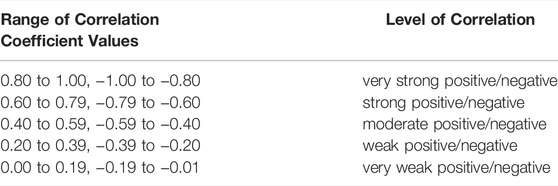
TABLE 4. Correlation coefficient values and strength of correlation between variables (adapted from Meghanathan, 2016).
To correctly interpret the correlation coefficient, it is necessary to calculate the significance of the correlation coefficient in the form of the p-value. In this case, the p-value was determined at a level of less than α = 0.05, assuming that there is only a 5% probability that the results from the sample considered occurred accidentally. The null hypothesis is that there is no statistically significant relationship between the current efficiency of the maintenance management process and the current state of observed management factors. The results indicate that: if the p-value is ≤ α, the correlation is statistically significant, the null hypothesis is rejected; if the p-value is > α, the correlation is not statistically significant, the null hypothesis is not ruled out. The results of the correlation analysis are presented in Table 5.
The results show a certain correlation between almost all observed variables and the current effectiveness of the overall maintenance management process. Given the amounts of p-values, in most cases, the correlation coefficients must not be interpreted, the null hypotheses cannot be rejected, the results are not valid for the entire school population, and they should be examined on a larger data sample.
Correlation coefficients that have high significance are those between the current efficiency of the overall maintenance management process and the overall state of the school, design solution, defined maintenance standard, performance measurement with performance indicators. The most significant connection has proved to be with a current state of design solution therefore, it is recommended that during the renovation of old and construction of new school buildings, a maintenance expert should be included in the design phase, thus achieving savings in later stages of building maintenance and use and achieving more efficient maintenance management overall (Tijanić Štrok, 2021).
In the third part of the questionnaire, principals highlighted the current maintenance problems presented in Figure 5.
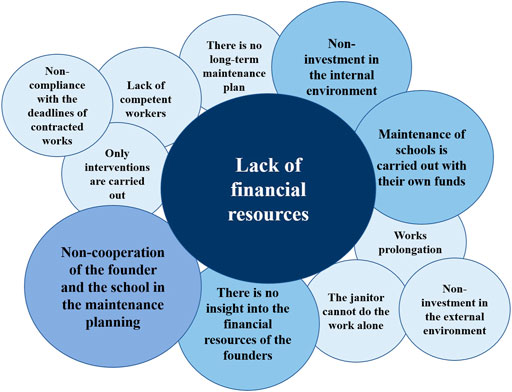
FIGURE 5. Highlighted problems in the current schools’ maintenance management process according to principals.
The largest number of principals stressed that adequate maintenance lacks financial resources. Therefore, the funds available must be spent more efficiently and purposefully, which can be achieved by proper planning, increasing the number of preventive works, better organization, supervision and control, etc. The problem highlighted by several principals was the lack of cooperation between the school founders and the principals in planning future maintenance, and the schools also are not familiar with the funds founders intend to invest. The persons in charge of school maintenance should work together, on the team, but everyone should have a role that contributes to the achievement of the goals set, and the founder and principal should be the ones who encourage work and cooperation (Tijanić Štrok, 2021).
To improve the current state of the school maintenance management process overall, according to Tijanić Štrok, (2021), it is recommended that a new maintenance management model be implemented in schools. This model is a kind of graphic and descriptive maintenance manual that directs school leaders and all other stakeholders on how to achieve the effective performance of maintenance management activities. In particular, the use of a CMMS is emphasized within the model. The model provides instructions and guidelines for actions within the planning, organization, directing, and controlling of maintenance activities in school buildings, as well as within other phases of the construction project.
After the results are presented, the fulfillment of the research goal will be checked and the hypotheses will be tested.
The research established a methodological framework for analyzing the current school maintenance management process, thus achieving the primary objective of this paper and thus confirming the first research hypothesis. The analysis of the collected data showed that maintenance management of studied schools is not fully efficient, that is, there are certain inadequacies and problems identified within this chapter of the paper, thus proving the second research hypothesis. All identified inadequacies can be affected by certain measures, which need to be systematically considered and decisions made that will improve the current situation. One of the essential measures is undoubtedly the change of the overall business by introducing a new maintenance management model.
The following can be emphasized if a parallel is drawn between the theoretical background of the observed maintenance problem and the research conducted here. In the Republic of Croatia, there is no systematic research on the maintenance and condition of school buildings, and on the world stage, there are no studies that approach the schools’ maintenance in a way that examines the functioning of the entire maintenance management process. The purpose of this paper was to close the gaps in the literature, suggest an approach, and conduct research that can be applied to larger areas and other buildings to identify shortcomings in the maintenance process and its management. Main problems in world research were also confirmed in a study area in which: older school buildings that are inefficiently maintained are in operation; maintenance struggles with a limited budget; a clear policy and standard of maintenance is lacking; sufficient attention is not paid to maintenance when designing buildings which according to the results of this research is a crucial factor for effective maintenance management. In addition to these inadequacies, shortcomings in measuring maintenance performance with performance indicators as well as measuring user satisfaction, and the lack of training for school principals, were also shown. The backwardness of Croatian schools is particularly evident in applying computer systems for maintenance management.
Both the literature review and this research have shown that additional efforts need to be made to improve the overall school maintenance process to create an environment in which students can reach their full potential. Measures proposal to overcome the identified deficiencies in maintenance management is given in the next chapter.
5 Conclusion
The research was conducted on the current state of the maintenance management process in elementary schools in Primorje-Gorski Kotar County. So far, no comprehensive research on school buildings maintenance and related issues has been conducted in the Republic of Croatia. The research aim has been achieved and hypotheses have been confirmed.
Main research results indicate that the observed school buildings are old and the creation of their design solutions did not consider the influence on subsequent maintenance, which, according to the size of the correlation coefficient, has a pronounced influence on the overall efficiency of the maintenance management process. There is no record of the operational state of school buildings based on which a particular system of school maintenance priorities could be developed. Schools do not have sufficient maintenance funds available that would meet all their maintenance needs, which is the responsibility of the state government. Still, since the increase in funds is not likely, it is essential to consider all ways to spend them more effectively. Since many stakeholders participate in school maintenance, it is necessary to achieve better cooperation and teamwork, which has not been the case so far. One of the distinguished stakeholders are principals, who head the school buildings and all maintenance requirements have a starting point in them, but they do not have any maintenance knowledge. The school maintenance policy and standard are not defined well enough, nor is there a system for measuring the overall maintenance performance. The use of CMMS has almost not been reported at all.
If the obtained results are compared with world studies, it is evident that school maintenance in the Republic of Croatia follows similar negative trends.
The observed inadequacies in Croatian schools contribute to the inefficiency of the current maintenance management process, so the following set of essential recommendations is given:
• the condition of school buildings should be recorded in detail, based on which an investment priority system will be developed, which will ensure the most critical and necessary work at the beginning of maintenance plans and enable more transparent planning of capital projects and maintenance work;
• the ways and procedure in which maintenance takes place in schools should be precisely defined in the form of a maintenance policy that will make it clear how maintenance decisions are made and who is involved in this process;
• the standard on which schools are maintained should be determined, which will achieve the satisfaction of the Basic Requirements for Construction Works (BRCW), functional conditions, aesthetic conditions, and not least important, users satisfaction;
• education and training should be conducted regularly for all persons involved in the school maintenance process, especially for principals who are in charge of schools and who are chronically lacking in technical knowledge;
• cooperation between schools and their founders should be improved, primarily during the planning and reallocation of financial resources for maintenance, so that founders have a better insight into the specific user needs and work of the school;
• a system of key performance indicators should be developed based on which maintenance performance will be measured and, given the results of measurements, improvements will be made in problematic maintenance areas; this is very important for the continuous improvement of the overall process of maintenance management in schools;
• it is especially necessary to measure the satisfaction of students and staff; effective learning and teaching can only take place in a user-friendly environment, so it is necessary to examine how satisfied they are with that environment and to identify areas where special attention should be paid according to them;
• CMMS should be implemented to facilitate maintenance management; the software will enable more efficient communication and faster and easier maintenance planning, directing staff to activities, planning resource consumption, monitoring maintenance costs and times, keeping maintenance records, documenting data on failures, damage, their causes, etc.; the software includes all functions and management factors as well as persons involved in maintenance, from technical staff to the founder;
• when designing school buildings, maintenance experts should be involved in this process to develop a solution that will have the most cost-effective performance during the building use phase.
All these recommendations, as well as improvements in other school maintenance segments, should be included through a new maintenance management model that will show the way to the effective functioning of the entire management process. Through this model, maintenance is taken care of from the earliest stages of the project, from design. Within the model, the use of CMMS is particularly emphasized. This model should instruct school leaders and other stakeholders on how to plan, organize, lead, and control maintenance activities. Future research should go in the direction of detailed elaboration and implementation of such a model in schoolwork.
The population studied in this paper is limited to elementary school buildings in Primorje-Gorski Kotar County in the Republic of Croatia, which is one of the limitations of the research, therefore the obtained results on the state of management process cannot be presumed for other schools because there is no statistical justification for this. The study is also limited by the scope of theoretical analysis based on which the studied management factors are determined. Although a comprehensive literature analysis has been carried out, there is always the possibility of omitting a certain source of literature that may be relevant for the research.
Regardless of limitations, the developed methodological framework, along with potential minor modifications, can be applied to schools from other areas as well as to other types of buildings, which can provide a good insight into the current state of their maintenance management process, based on which they can then improve their operations in the maintenance segment.
Data Availability Statement
The original contributions presented in the study are included in the article/Supplementary Material, further inquiries can be directed to the corresponding author.
Author Contributions
KTŠ designed and conducted the research and wrote the manuscript. SM and DC-P provided guidance, read and revised drafts of the manuscript text and figures, and helped develop and advance the manuscript. All authors contributed to the article and approved the submitted version.
Funding
This work has been supported by the University of Rijeka under the project numbers uniri-tehnic-18-125 and uniri-pr-tehnic-19-18.
Conflict of Interest
The authors declare that the research was conducted in the absence of any commercial or financial relationships that could be construed as a potential conflict of interest.
Publisher’s Note
All claims expressed in this article are solely those of the authors and do not necessarily represent those of their affiliated organizations, or those of the publisher, the editors and the reviewers. Any product that may be evaluated in this article, or claim that may be made by its manufacturer, is not guaranteed or endorsed by the publisher.
References
Albader, H., and Kandil, A. (2013). An Agent-Based Framework of a Maintenance Budget Allocation System for Educational Facilities. GEN 62 (1), 1–9.
Ali, A. S., Keong, K. C., Zakaria, N., Zolkafli, U., and Akashah, F. (2013). The Effect of Design on Maintenance for School Buildings in Penang, Malaysia. Struct. Surv. 31 (3), 194–201. doi:10.1108/SS-10-2012-0030
Aliyu, A., Bello, A., Muhammad, S., Singhry, M., and Bukar, M. G. (2016). “An Assessment of Building Maintenance Management Practice for Abubakar Tafawa Balewa University Teaching Hospital, Bauchi,” in Proceedings/Abstracts and Programmes of the Academic Conference on Transformation Assessment, 12–20.
Alshehri, A. R. (2016). Quality Management System for Building Maintenance. PhD Thesis. Edinburgh: Heriot-Watt University.
Alzaben, H. (2015). Development of a Maintenance Management Framework to Facilitate the Delivery of Healthcare Provisions in the Kingdom of Saudi Arabia. PhD Thesis. Nottingham: Nottingham Trent University.
Capak, K., Barišin, A., Brdarić, D., Jeličić, P., Janev, N., Poljak, V., et al. (2015). Zdravstveno-ekološki Čimbenici U Osnovnim Školama U Republici Hrvatskoj. Croatian Institute of Public Health. Available at: https://www.hzjz.hr/download/DIZAJN_BROSURE_HZJZ_WEB.pdf (Accessed May 10, 2022).
de Morais, G. A. T., and Lordsleem Júnior, A. C. (2019). Building Maintenance Management Activities in a Public Institution. Ecam 26 (1), 85–103. doi:10.1108/ECAM-01-2018-0024
Dickerson, D. E., and Ackerman, P. J. (2016). Risk-based Maintenance Management of U.S. Public School Facilities. Procedia Eng. 145, 685–692. doi:10.1016/j.proeng.2016.04.069
El Shorafa, F. E. (2013). Key Performance Indicators for Maintenance in Hospitals Buildings in Gaza Strip. PhD Thesis. Gaza: The Islamic University of Gaza.
ElSamadony, A., Hossny, O., ElHakeem, A., and Hussein, D. (2013). An Asset Management System for Maintenance and Repair of Educational Buildings. Int. J. Sci. Eng. Res. 4 (6), 2053–2064.
Gala Mong, S., Fikri Mohamed, S., and Mohd. Saidin Misnan, M. (2018). Maintenance Management Model: an Identification of Key Elements for Value-Based Maintenance Management by Local Authority. Int. J. Eng. Tech. 7 (325), 35–43. doi:10.14419/ijet.v7i3.25.17467
Harun, M. T., Salamudin, N., and Hushin, H. F. (2013). Appraisal of the Sport Facilities Maintenance Management Practices of Malaysian Stadium Corporations. Asian Social Science 9 (12), 93. doi:10.5539/ass.v9n12p93
Izobo-Martins, O. (2014). Maintenance Strategies and Condition of Public Secondary School Buildings in Ado-Odo/Ota Local Government Area Ogun State, Nigeria. PhD Thesis. Ota: Covenant University.
Jandali, D., and Sweis, R. (2019). Factors Affecting Maintenance Management in Hospital Buildings. Int. J. Build. Patho. Adaptation 37 (1), 6–21. doi:10.1108/IJBPA-12-2017-0064
Katić, D., Krstić, H., and Marenjak, S. (2021). Energy Performance of School Buildings by Construction Periods in Federation of Bosnia and Herzegovina. Buildings 11 (2), 42. doi:10.3390/buildings11020042
Kim, J.-M., Kim, T., Yu, Y.-J., and Son, K. (2018). Development of a Maintenance and Repair Cost Estimation Model for Educational Buildings Using Regression Analysis. J. Asian Archit. Build. Eng. 17 (2), 307–312. doi:10.3130/jaabe.17.307
Kušljić, D. (2012). Determination of Criteria for Evaluating the Success of Public-Private Partnership Construction Projects. PhD Thesis. Osijek: University of Josip Juraj Strossmayer in Osijek.
Lee, C-K., and Jeon, Y-I. (2017). A Maintenance Cost Prediction Model for Elementary Schools by Correcting FM Budget History and Performance Data. Int. J. Appl. or Innovation Eng. Manag. 6 (5), 084–094.
Liu, S.-S., and Faizal Ardhiansyah Arifin, M. (2021). Preventive Maintenance Model for National School Buildings in Indonesia Using a Constraint Programming Approach. Sustainability 13 (4), 1874. doi:10.3390/su13041874
Marzouk, M., and Awad, E. (2016). Establishing Multi-Level Performance Condition Indices for Public Schools Maintenance Program Using AHP and Fuzzy Logic. Stud. Inf. Control 25 (3), 343–352. doi:10.24846/v25i3y201608
Meghanathan, N. (2016). Assortativity Analysis of Real-World Network Graphs Based on Centrality Metrics. Cis 9 (3), 7–25. doi:10.5539/cis.v9n3p7
Nah, M. N. N., Abdullah, S., Razak, A. A., and Hanafi, M. H. (2012). Property Management Implementation Problems within Malaysian Public School. Int. J. Soc. Sci. 1 (1), 17–28.
Nik-Mat, N. E. M., Kamaruzzaman, S. N., and Pitt, M. (2011). Assessing the Maintenance Aspect of Facilities Management through a Performance Measurement System: A Malaysian Case Study. Procedia Eng. 20, 329–338. doi:10.1016/j.proeng.2011.11.174
Ochien'g, R. R. (2012). Developing a Model Framework for Effective Maintenance of Public Office Buildings in Kenya: A Survey of Multi Storeyed Office Buildings in NairobiPhD Thesis. Nairobi: Jomo Kenyatta University of Agriculture and Technology.
Ogunoh, P. E., Mbanusi, E. C., and Okoye, U. P. (2018). Effective Implementation of Maintenance Models in Building Maintenance Process. J. Eng. Res. Rep. 1–10. doi:10.9734/JERR/2018/43466
Olanrewaju, A. L. A., and Abdul-Aziz, A. R. (2014). Building Maintenance Processes and Practices: The Case of a Fast Developing Country. New York: Springer.
Oyenuga, S. O., Akinsola, O. E., Hussaini, P. O., and Fatokun, A. O. (2012). Maintenance of University Facilities in Developing Country: Case Study of Lagos State University Ojo Nigeria. Mediterr. J. Soc. Sci. 3 (11), 69–75. doi:10.5901/mjss.2012.v3n11p69
Palis, P., and Saidin Misnan, M. (2018). A Review of Key Factors that Affect University Building Maintenance Costs. Int. J. Eng. Tech. 7 (325), 32–34. doi:10.14419/ijet.v7i3.25.17466
Primorje-Gorski Kotar County (2020). O Županiji. Available at: https://www.pgz.hr/o-zupaniji/(Accessed January 24, 2022).
Ropi, R. M., and Tabassi, A. A. (2014). Study on Maintenance Practices for School Buildings in Terengganu and Kedah, Malaysia. In O. Mydin Proceedings of Building Surveying and Technology Undergraduate Conference. Langkawi, Malaysia, doi:10.1051/matecconf/20141003003
Saraiva, T., De Almeida, M., Bragança, L., and Barbosa, M. (2018). Environmental Comfort Indicators for School Buildings in Sustainability Assessment Tools. Sustainability 10 (6), 1849. doi:10.3390/su10061849
Sharma, D. (2020). The Importance of School Education in Child Development. Available at: https://www.educationworld.in/the-importance-of-school-education-in-child-development/(Accessed January 20, 2022).
Shohet, I. M., and Nobili, L. (2017). Application of Key Performance Indicators for Maintenance Management of Clinics Facilities. Int. J. Strategic Prop. Manag. 21 (1), 58–71. doi:10.3846/1648715X.2016.1245684
State Audit Office (2018). Izvješće O Obavljenoj Reviziji Učinkovitosti Kapitalnih Ulaganja U Osnovne I Srednje Škole Na Području Republike Hrvatske. Sisak.
Teixeira, J., Amoroso, J., and Gresham, J. (2017). Why Education Infrastructure Matters for Learning. Available at: https://blogs.worldbank.org/education/why-education-infrastructure-matters-learning (Accessed January 24, 2022).
The Government of the Republic of Croatia (2012). Okvirni Program Izgradnje, Dogradnje I Rekonstrukcije Javnih Građevina Prema Ugovornom Obliku Javno Privatnog Partnerstva. Available from: https://investcroatia.gov.hr/wp-content/uploads/2015/11/okvirni-program-jpp.pdf (Accessed April 25, 2022).
Tijanić Štrok, K. (2021). Development of the Model for Efficient Maintenance Management of Public Educational Buildings. PhD Thesis. Osijek: University of Josip Juraj Strossmayer in Osijek.
Velmurugan, R. S., and Dhingra, T. (2015). Maintenance Strategy Selection and its Impact in Maintenance Function. Int. J. Operations Prod. Manag. 35 (12), 1622–1661. doi:10.1108/IJOPM-01-2014-0028
Vieira, A. C. V., and Cardoso, A. J. M. (2014). “Maintenance Conceptual Models and Their Relevance in the Development of Maintenance Auditing Tools for School Buildings' Assets: an Overview,” in Proceedings of Maintenance Performance Measurement and Management Conference, 3–10. doi:10.14195/978-972-8954-42-0_1
Wing, A. C. K., Mohammed, A. H., and Abdullah, M. N. (2016). A Review of Maintenance Priority Setting Methods. Int. J. Real Estate Stud. 10 (2), 1–9.
Wuni, I. Y., Agyeman-Yeboah, S., and Boafo, H. K. (2017). Poor Facility Management in the Public Schools of Ghana; Recent Empirical Discoveries. J. Sustain. Dev. Stud. 11 (1), 1–30.
Xaba, M. I. (2012). A Qualitative Analysis of Facilities Maintenance - a School Governance Function in South Africa. Saje 32 (2), 215–226. doi:10.15700/saje.v32n2a548
Keywords: maintenance, maintenance management, school buildings, elementary schools, Primorje-Gorski Kotar County, current state
Citation: Tijanić Štrok K, Marenjak S and Car-Pušić D (2022) Analysis of the Current Maintenance Management Process in School Buildings: Study Area of Primorje-Gorski Kotar County, Republic of Croatia. Front. Built Environ. 8:912326. doi: 10.3389/fbuil.2022.912326
Received: 04 April 2022; Accepted: 02 May 2022;
Published: 30 May 2022.
Edited by:
Ivan Zambon, Other, AustriaReviewed by:
Valentino Sangiorgio, University of Studies G d'Annunzio Chieti and Pescara, ItalyVít Hromádka, Brno University of Technology, Czechia
Copyright © 2022 Tijanić Štrok, Marenjak and Car-Pušić. This is an open-access article distributed under the terms of the Creative Commons Attribution License (CC BY). The use, distribution or reproduction in other forums is permitted, provided the original author(s) and the copyright owner(s) are credited and that the original publication in this journal is cited, in accordance with accepted academic practice. No use, distribution or reproduction is permitted which does not comply with these terms.
*Correspondence: Ksenija Tijanić Štrok, a3NlbmlqYS50aWphbmljQHVuaXJpLmhy
 Ksenija Tijanić Štrok
Ksenija Tijanić Štrok Saša Marenjak2
Saša Marenjak2 Diana Car-Pušić
Diana Car-Pušić